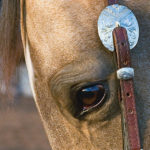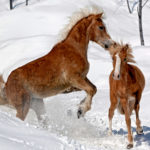The USDF Guide to Dressage (available on Amazon) explains the sport and competition from the ground up. Below is an excerpt from the book, written by Jennifer O. Bryant:

At some point in your dressage studies, you might get bitten by the competitive bug and yearn to test your skills at a show. You also might recognize that competition is an excellent way to get an expert’s impartial assessment of where you are in your training, as well as a road map for your continuing education. Even if you have no desire to compete, you might attend a dressage show and discover the unique learning opportunities that come from being a spectator.
Whatever the case, it’s helpful to understand how dressage shows are run and what the riders are doing.
Dressage Letters From A to X
A standard dressage arena is 20 by 60 meters. The letters around the perimeter of the arena are displayed on markers of various styles, customarily black type against a white background. In an outdoor arena, the markers may be attached to metal stakes that are driven into the ground, or they might be freestanding white pylons. Upscale shows tend to use fancier markers, such as tall box planters, with letters painted on the side and attractive flower arrangements on top. In indoor arenas, flat letter markers are usually nailed to the walls at the appropriate locations.
The letters along the center line–D, L X, I and G–are not posted in the arena itself, because that’s where you’re riding. However, the letters for the center line are frequently listed on the letter markers for the perimeter. The perimeter letter is large, and the centerline letter is smaller and set beneath.
There’s only one way in and out of a dressage arena at a show, and that’s the opening at A. At large shows, volunteers stand a discreet distance away from A and place a section of arena rail across the opening to close it off after the horse enters the arena; they remove it to let the horse exit after the test is completed. At smaller snows, the opening remains throughout.
Most dressage shows have only one judge per class. A single judge always sits at C (technically, the judge sits behind C, allowing room for a horse to pass between the rail and herself) because this position affords the best view and perspective of the entire arena. At some larger shows and in certain higher-level classes, more than one judge views each class; the head judge always sits at C. In a three-judge panel, the judges are seated at H, C and B, or at E, C and M. The largest classes, such as at the Olympic Games and other international competitions, require panels of five judges; the judges sit at C, H, M, E and B.
A Fat Black Mare Can Hardly Ever Kick
This silly saying is a mnemonic device for remembering the major dressage letters at the endpoints, corners and midpoints of the arena. Beginning at A and working your way counterclockwise (on the left rein) around the arena, you’ll pass F, B, M, C, H, E and K. There are other mnemonics, but “Fat Black Mare” was the first one I learned, and it stuck. Feel free to substitute another one or make up your own.
It’s easy to remember where X is because it’s the center point of the arena. Every test or competition dressage ride begins and ends with a halt and a salute to the judge or ground jury (panel of judges). X is where most such halts and salutes are designated to occur.
The in-between letters (P,R,S and V around the perimeter of the arena and D, L, I and G on the centerline) aren’t associated with any mnemonic devices that I’m aware of, so when the time comes, you’ll just have to pound those letters into memory. They are seldom used in the lowest-level tests, so you may not need to learn them for a while.
The Levels
Simply put, the levels are the dressage-training progression delineated for the purposes of competition. They are a tangible expression of the dressage training scale, or pyramid of training. To test the horses–and riders–mastery of the training progressions, gaits, paces and movements that are considered skill-appropriate for various progressive stages in training are identified and pieced together in choreographed patterns called dressage tests or tests. Each level is designated by a name. The tests at the various levels are written by the organization that governs those particular competition levels.
Every country that sanctions dressage competition has a national federation that writes and governs its national-level dressage tests and rules. In the United States, the U.S. Equestrian Federation is our national federation, and it’s responsible for Training through Fourth level. The USEF Dressage Committee writes these tests and amends and updates them every four years.
The United States Dressage Federation, which is primarily an educational organization, not a dressage governing body, saw a need for tests that were less difficult than the Training Level, the most elementary USEF level. So the USDF developed Introductory Level as an inviting educational alternative so that novice dressage horses and riders could get their feet wet and familiarize themselves with dressage-show protocol.
If you’re thinking even vaguely about showing, first you need to determine which level is most appropriate for you and your horse. Start by reading through the list of required gaits, paces and movements for each level. (Training through Second levels are discussed below.) If one of the required elements is not a strong part of your repertoire, it would be best to become proficient in the element before showing or to drop down a level.
While you’re tracking your dressage points, track how much you’re earning from AQHA’s Incentive Fund program. If your horse is enrolled, you’ll earn points and money for doing what you love: showing your horse.
In Germany and some other countries, dressage riders are required to start competing at the lowest level and must earn the right to move up; that’s not the case in the United States. With the exception of certain championship classes and other classes with age and membership requirements, we are free to enter any class we please. Whether this policy is the American way or the road to mediocrity is a subject of lively debate among dressage enthusiasts.
The Levels Explained
The lists that follow summarize the key gaits, paces and movements of the levels covered in The USDF Guide to Dressage. Each level consists of two or more tests (patterns), which increase in difficulty somewhat as the test numbers increase. The required elements are listed in the order in which they’re introduced in the tests; the later movements present new challenges.
Introductory Level
The USDF Introductory Level tests aren’t offered at all USEF/USDF-recognized (sanctioned) dressage competitions, but they’re a staple at dressage schooling shows, which are low-pressure affairs designed to give horses and riders valuable competition and educational experience.
Introductory Level is walk-trot only; there’s no cantering. As such, Introductory Level is often ridden in a small dressage arena (20 by 40 meters) because the extra room of the standard arena really isn’t needed.
Key elements
Medium walk
Free
walk
Working trot, rising
20-meter trot circles
Halt through medium walk
Training Level
Almost every dressage show, whether recognized or unrecognized, offers Training Level classes, which are the lowest of the USEF national levels. The biggest difference between Introductory and Training Level is that all Training Level classes include canter work.
Training Level classes may be held in either the standard or the small arena.
Key elements
Medium walk
Free walk
Working trot (either sitting or riding is acceptable, unless otherwise stated)
20-meter circles in trot and canter
Trot-canter and canter-trot transitions between two letters or at the letter
Halts through the walk are OK
20-meter stretching circle at the trot (rider allows the horse to stretch forward and downward, then takes up the reins at the conclusion of the circle.
One-loop serpentine in trot.
First Level
First Level introduces the lengthening of the stride and some basic lateral work in the form of the leg yield. Serpentines test the horse’s balance, bend and suppleness.
Key elements
Medium walk
Free walk
Working trot
Trot lengthenings
Trot work is done sitting unless the test states otherwise
Halts from the trot (halts executed through the walk are no longer permitted)
10-meter half circles and full circles in trot
Three-loop serpentines in trot
15-meter canter circles
Trot leg yield
Canter lengthenings
5-second halt in the middle of the test
Change of canter lead through the trot (two or three trot strides before picking up the new canter lead)
One-loop canter serpentine, maintaining the same lead (shallow counter-canter in middle of loop)
Second Level
Second Level is a significant step up from First Level because collection is introduced and with it some more advanced lateral movements. At this level, all trot work is done sitting.
Key elements
Medium walk
Free walk
Collected trot
Medium trot
Collected canter
Medium canter
Two- and three-loop serpentines in collected trot and canter (canter loops with no change of lead)
Shoulder-in in trot
Rein back (backing up) of three to four steps
Simple changes of lead (change of canter lead through the walk, with just a couple of walk steps [no trotting!] between canter leads)
10-meter circles in canter
Travers (haunches in) in trot
Counter-canter
Stretching circle in canter (horse is expected to stretch forward while remaining round and balanced)
Renvers (haunches-out) in trot
Half-turns on the haunches in the walk
Three-loop serpentine in collected canter with a simple change of lead at every crossing of the center line.





